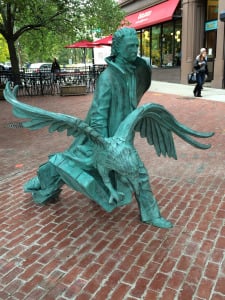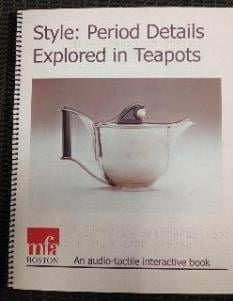Boston fashioned its revolutionary identity hurling tea into the Boston Harbor—an iconic event that inspired a second Tea Party movement hundreds of years later. But this post is about a third Boston tea party event, not as well-known, but revolutionary in its own right.
Several months ago, four of us—Mike Mellor, author of Louis Braille: A Touch of Genius, Ann Cunningham, a renowned sculptor and tactile artist, JoAnn Becker, an NBP Trustee and technology trainer at Perkins, and myself, a publisher at NBP—attended the unveiling of the Edgar Allan Poe statue in Boston.  One of the best-kept secrets of Boston’s literary history is the fact that Edgar Allan Poe was born here.
One of the best-kept secrets of Boston’s literary history is the fact that Edgar Allan Poe was born here.
Moments after they removed the covering from his life-size statue, the four of us pushed hard against an enormous crowd to get close enough to touch Poe’s swirling cape, to trace the enormous wingspan of his raven, even to insert our hands into the raven’s screeching beak. It was a moment of shared accessibility and we felt giddy.
In fact, it was the second time that day that we shared a moment of culture and art. Earlier, passing by the Museum of Fine Arts, we spontaneously decided to venture in to see what might be accessible to us all. As we walked through the heavy doors, Ann suddenly remembered that she had worked with Steve Landau at Touch Graphics, and Hannah Goodwin, Manager of Accessibility at the Museum, to create a tactile book that explores American Style through the centuries by showcasing contrasting teapot designs!
Each era was illustrated with an example of a teapot  created in that period’s style, and embossed in low relief. Accompanying text, in large print and braille, described each design in detail. The coup d’ grace was an electronic pen that, when any element of the design was touched, would provide even more information. Unfortunately the battery in the pen had run out and we were not able to access this feature. But by now our batteries were already charged with this unexpected treat, as Ann and JoAnn sat down on an ancient museum bench to explore Style: Period Details Explored in Teapots as tactile designer and art devotee respectively.
created in that period’s style, and embossed in low relief. Accompanying text, in large print and braille, described each design in detail. The coup d’ grace was an electronic pen that, when any element of the design was touched, would provide even more information. Unfortunately the battery in the pen had run out and we were not able to access this feature. But by now our batteries were already charged with this unexpected treat, as Ann and JoAnn sat down on an ancient museum bench to explore Style: Period Details Explored in Teapots as tactile designer and art devotee respectively.
“I feel I have as clear a vision of what those teapots look like, and each unique period’s design, as anyone sighted,” said JoAnn, as we left the museum. “I had no idea until today that I prefer the Federalist period of teapots over the Empire era and precisely why!”
It seemed an ordinary and an extraordinary afternoon among friends—as simple and yet as exquisite as a teapot.
